Auditory brain stem response to complex sounds: a tutorial
- PMID: 20084007
- PMCID: PMC2868335
- DOI: 10.1097/AUD.0b013e3181cdb272
Auditory brain stem response to complex sounds: a tutorial
Abstract
This tutorial provides a comprehensive overview of the methodological approach to collecting and analyzing auditory brain stem responses to complex sounds (cABRs). cABRs provide a window into how behaviorally relevant sounds such as speech and music are processed in the brain. Because temporal and spectral characteristics of sounds are preserved in this subcortical response, cABRs can be used to assess specific impairments and enhancements in auditory processing. Notably, subcortical auditory function is neither passive nor hardwired but dynamically interacts with higher-level cognitive processes to refine how sounds are transcribed into neural code. This experience-dependent plasticity, which can occur on a number of time scales (e.g., life-long experience with speech or music, short-term auditory training, on-line auditory processing), helps shape sensory perception. Thus, by being an objective and noninvasive means for examining cognitive function and experience-dependent processes in sensory activity, cABRs have considerable utility in the study of populations where auditory function is of interest (e.g., auditory experts such as musicians, and persons with hearing loss, auditory processing, and language disorders). This tutorial is intended for clinicians and researchers seeking to integrate cABRs into their clinical or research programs.
Figures

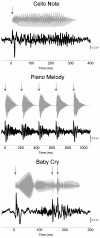

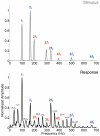


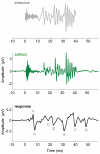
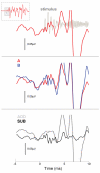

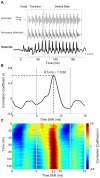


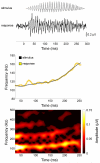
Comment in
-
Guest editorial: Auditory brain stem testing: new adventures with the old auditory brain stem response.Ear Hear. 2010 Jun;31(3):301. doi: 10.1097/AUD.0b013e3181d70247. Ear Hear. 2010. PMID: 20440113 No abstract available.
Similar articles
-
Objective neural indices of speech-in-noise perception.Trends Amplif. 2010 Jun;14(2):73-83. doi: 10.1177/1084713810380227. Trends Amplif. 2010. PMID: 20724355 Free PMC article. Review.
-
Musical training orchestrates coordinated neuroplasticity in auditory brainstem and cortex to counteract age-related declines in categorical vowel perception.J Neurosci. 2015 Jan 21;35(3):1240-9. doi: 10.1523/JNEUROSCI.3292-14.2015. J Neurosci. 2015. PMID: 25609638 Free PMC article.
-
Guest editorial: Auditory brain stem testing: new adventures with the old auditory brain stem response.Ear Hear. 2010 Jun;31(3):301. doi: 10.1097/AUD.0b013e3181d70247. Ear Hear. 2010. PMID: 20440113 No abstract available.
-
Relationships between behavior, brainstem and cortical encoding of seen and heard speech in musicians and non-musicians.Hear Res. 2008 Jul;241(1-2):34-42. doi: 10.1016/j.heares.2008.04.013. Epub 2008 May 17. Hear Res. 2008. PMID: 18562137 Free PMC article.
-
The layering of auditory experiences in driving experience-dependent subcortical plasticity.Hear Res. 2014 May;311:36-48. doi: 10.1016/j.heares.2014.01.002. Epub 2014 Jan 18. Hear Res. 2014. PMID: 24445149 Review.
Cited by
-
Subcortical responses to music and speech are alike while cortical responses diverge.Sci Rep. 2024 Jan 8;14(1):789. doi: 10.1038/s41598-023-50438-0. Sci Rep. 2024. PMID: 38191488 Free PMC article.
-
Cortical responses time-locked to continuous speech in the high-gamma band depend on selective attention.Front Neurosci. 2023 Dec 14;17:1264453. doi: 10.3389/fnins.2023.1264453. eCollection 2023. Front Neurosci. 2023. PMID: 38156264 Free PMC article.
-
Athleticism and sex impact neural processing of sound.Sci Rep. 2022 Sep 7;12(1):15181. doi: 10.1038/s41598-022-19216-2. Sci Rep. 2022. PMID: 36071146 Free PMC article.
-
Continued maturation of the click-evoked auditory brainstem response in preschoolers.J Am Acad Audiol. 2015 Jan;26(1):30-5. doi: 10.3766/jaaa.26.1.4. J Am Acad Audiol. 2015. PMID: 25597458 Free PMC article.
-
Inhibitory effects of prepulse stimuli on the electrophysiological responses to startle stimuli in the deep layers of the superior colliculus.Front Neurosci. 2024 Aug 14;18:1446929. doi: 10.3389/fnins.2024.1446929. eCollection 2024. Front Neurosci. 2024. PMID: 39211433 Free PMC article.
References
-
- Abel C, Kossl M. Sensitive response to low-frequency cochlear distortion products in the auditory midbrain. J Neurophysiol. 2009;101:1560–1574. - PubMed
-
- Addison P, Walker J, Guido R. Time-frequency analysis of biosignals. IEEE Eng Med Biol Mag. 2009;28:14–29. - PubMed
-
- Aiken SJ, Picton TW. Envelope following responses to natural vowels. Audiol Neurootol. 2006;11:213–232. - PubMed
-
- Aiken SJ, Picton TW. Envelope and spectral frequency-following responses to vowel sounds. Hear Res. 2008;245:35–47. - PubMed
-
- Akhoun I, Gallego S, Moulin A, et al. The temporal relationship between speech auditory brainstem responses and the acoustic pattern of the phoneme /ba/ in normal-hearing adults. Clin Neurophysiol. 2008a;119:922–933. - PubMed
Publication types
MeSH terms
Grants and funding
LinkOut - more resources
Full Text Sources
Other Literature Sources
Medical

